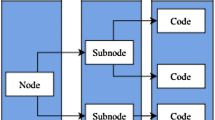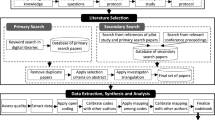Abstract
Do the inventors of radio “fences” (which restrict transmissions externalities) care about property rights? I hypothesize that inventors do pay attention to policy regimes such as licensed and unlicensed spectrum when building technologies to handle interference. To answer this question, I conduct textual analysis of 500,000 wireless patents to estimate inventor attention to property rights. I find that inventors are more likely to mention interference and sensor technology if they mention property rights, than if they do not discuss property rights. While further research is needed to determine causality, textual analysis provides evidence of inventor attention to property rights regimes.






Similar content being viewed by others
Notes
The Radio Act of 1927, Public Law No. 632, February 23, 1927, 69th Congress.
For a brief summary of textual analysis, see generally, Merrick, Amy, “Why Words are the New Numbers,” Chicago Booth Review. Mar. 17, 2015, http://review.chicagobooth.edu/magazine/spring-2015/why-words-are-the-new-numbers.
I counted key terms taking into account the presence of a plural “s” or not. Several terms were counted with different spellings: Cancellation includes “cancellation” or “cancelation”; CFR includes “CFR,” “C.F.R.,” or “Code of Federal” Regulations; FCC includes “Federal Communications Commission” or “FCC”; TV includes “television” or “TV”; white space includes “white spaces” or “white space”; WiFi includes “Wi-Fi” or “WiFi”; and 3G includes “3G” or “3GPP.” The number of times that a term appeared in the full text of a patent was not measured, which is consistent with key term extraction methods in the literature.
Greene (2008).
Query results contained over 600,000 patents for the term “radio.” Data for this paper contains a sample of 500,000 of these listings from the search query.
Fewer than 500,000 observations appear in regression results due to some missing values in the textual analysis.
References
Bergeaud, A., Potiron, Y., & Raimbault, J. (2017). Classifying patents based on their semantic content. PLoS ONE,12(4), e0176310. https://doi.org/10.1371/journal.pone.0176310.
Carter, K., Lahjouji, A., & McNeil, N. (2003) Unlicensed and unshackled: A joint OSP-OET white paper on unlicensed devices and their regulatory issues. Federal Communications Commission, Office of Strategic Plan. & Policy, Working Paper No. 39, 13–21, https://apps.fcc.gov/edocs_public/attachmatch/DOC-234741A1.pdf. Accessed 23 Feb 2018.
Coase, R. (1959). The federal communications commission. Journal of Law and Economics,2, 1–40.
Daim, T., Rueda, G., Martin, H., & Gerdsri, P. (2006). Forecasting emerging technologies: Use of bibliometrics and patent analysis. Technological Forecasting and Social Change,73, 981–1012.
Greene, W. H. (2008). Econometric analysis, Chapter 23. In Models for discrete choice, 6th edn. Upper Saddle River, N.J.: Pearson/Prentice Hall.
Hazlett, T. (1998). Assigning property rights to radio spectrum users: Why did FCC license auctions take 76 years? Journal of Law and Economics,41, 529–576.
Hazlett, T., & Honig, M. (2016). Valuing spectrum allocations. Michigan Telecommunications & Technology Law Review,23, 45–111.
Lerner, J., & Seru, A. (2015). The use and misuse of patent data: Issues for corporate finance and beyond. Booth / Harvard Business School Working Paper. http://socialsciences.cornell.edu/wp-content/uploads/2015/03/The-Use-and-Misuse-of-Patent-Data.pdf. Accessed 23 Feb 2018.
O’Connor, S. M. (2015). Creators, innovators, and appropriation mechanisms. George Mason Law Review,22(4), 973–1000.
Tseng, Y.-H., Lin, C.-J., & Lin, Y.-I. (2007). Text mining techniques for patent analysis. Information Processing and Management,43, 1216–1247.
U.S. Patent & Trademark Office. (2017a). Patent full-text and image database, http://patft.uspto.gov/netacgi/nph-Parser?Sect1=PTO2&Sect2=HITOFF&u=%2Fnetahtml%2FPTO%2Fsearch-adv.htm&r=0&p=1&f=S&l=50&Query=rner=PALL. Accessed 23 Feb 2018.
U.S. Patent & Trademark Office. (2017b). U.S. patent statistics chart calendar years 1963–2015, https://www.uspto.gov/web/offices/ac/ido/oeip/taf/us_stat.htm. Accessed 23 Feb 2018.
Acknowledgements
The author thanks the Ronald Coase Institute Workshop on Institutional Analysis and the Ostrom Workshop of Indiana University Bloomington for the opportunity to present this paper in Bogota, Colombia in December 2017. The author appreciates comments from Scott Wallsten, Thomas Lenard, Mary Shirley, Michael Wiebe, and Thomas Hazlett. No funding or financial support was received for this paper.
Author information
Authors and Affiliations
Corresponding author
Appendix
Appendix
See Tables 9, 10, 11, 12, 13, 14 and 15.
Rights and permissions
About this article
Cite this article
Oh, S. Radio “Fences” and Inventor Attention to Property Rights: Evidence from Wireless Patents. Rev Ind Organ 56, 37–72 (2020). https://doi.org/10.1007/s11151-018-9665-5
Published:
Issue Date:
DOI: https://doi.org/10.1007/s11151-018-9665-5




